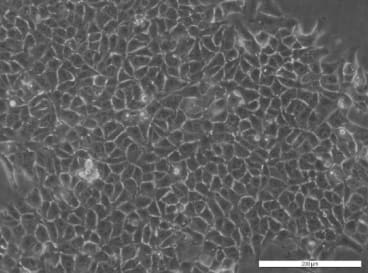CMT 167 Cell Line
Invented at Cancer Research UK London Research Institute: Lincoln's Inn Fields
- Datasheet
- References (8)
- Inventor Info
Info
| Catalogue Number | 151448 |
| Host | Mouse |
| Tissue | Lung |
| Disease Keywords | Lung carcinoma |
| Model | Tumour line |
| Relevance |
Highly metastatic murine alveogenic lung carcinoma cell line, derived from cell line CMT64, used to study the origins and causes of metastasis. Background and Research Application CMT167 was created in 1984 at Cancer research UK London Research Institute: Lincoln’s Inn Fields as a cell line with increased metastatic capabilities (selected from pooled lung metastases) from the CMT64 cell line. CMT 167 was isolated by subcloning and in vivo screening for high metastatic potential. CMT167 is a cell line of higher metastatic potential in comparison to CMT64 CMT 167 is an epithelial cell line, with closely packed sheets at confluence. It has an adherent culture type. |
| Production Details | Mouse; subclone of CMT 64 alveogenic lung carcinoma (isolated from primary tumour in C57BL/lcrf mouse), CMT 167 isolated by subcloning and in vivo screening for high metastatic potential. |
| Research Area | Cancer, Drug Discovery & Development |
| Growth/Phenotype Keywords | Tumourigenesis |
| Recommended Growing Conditions | CMT167 cell line can be grown in DMEM with 10% FCS, supplemented with 20mM Hepes |
| Notes |
Production Details Adult female mice (4-6 months) C57B/T were subcutaneously injected in the lower right flank with pooled tumour fragments from different non-necrotic areas of tumour with a Bashford needle – the cells from these tumours are on CMT64 origin. These cells were then cultured from lung metastases and the epithelial outgrowths were established as CMT167. Points of Interest CMT167 has a higher metastatic potential and has been used to help confirm that metastasis is a selective process of tumorigenesis and not random as previously thought, indicating that cell subpopulations have varying metastatic potential within a tumour. This however is twinned with host responses. One study found a tenfold greater number of lung metastases from CMT167 when compared to CMT170. This cell line is stable in tumorigenic and metastatic behaviour over time period (passages 6-46) with an increase in metastatic potential in later passages. In the original experiment to produce CMT167 cell line, the median number of pulmonary metastases in individual C57 mice was 27.5 with a range of 2 to 99. Concentration Vial has between 1-5 million cells as standard, however this may vary. |
| Cellosaurus ID | CVCL_2405 |
References: 8 entries
Tippimanchai et al. 2018. Oncoimmunology. 7(6):e1438105. PMID: 29872579.
Seshadri et al. 2018. Front Pharmacol. 9:759. PMID: 30061830.
Pelaz et al. 2017. ACS Nano. 11(3):2313-2381. PMID: 28290206.
Ismail et al. 2000. Cancer Res. 60(5):1173-6. PMID: 10728668.
Layton et al. 1984. Br J Cancer. 49(4):415-21. PMID: 6324836.
Heterogeneity in a spontaneous mouse lung carcinoma: selection and characterisation of stable metastatic variants.
Europe PMC ID: 6324836
Franks et al. 1976. Cancer Res. 36(3):1049-55. PMID: 1253168.
Metastasizing tumors from serum-supplemented and serum-free cell lines from a C57BL mouse lung tumor.
Europe PMC ID: 1253168
Add a reference
References: 8 entries
Tippimanchai et al. 2018. Oncoimmunology. 7(6):e1438105. PMID: 29872579.
Seshadri et al. 2018. Front Pharmacol. 9:759. PMID: 30061830.
Pelaz et al. 2017. ACS Nano. 11(3):2313-2381. PMID: 28290206.
Ismail et al. 2000. Cancer Res. 60(5):1173-6. PMID: 10728668.
Layton et al. 1984. Br J Cancer. 49(4):415-21. PMID: 6324836.
Heterogeneity in a spontaneous mouse lung carcinoma: selection and characterisation of stable metastatic variants.
Franks et al. 1976. Cancer Res. 36(3):1049-55. PMID: 1253168.
Metastasizing tumors from serum-supplemented and serum-free cell lines from a C57BL mouse lung tumor.
Add a reference





